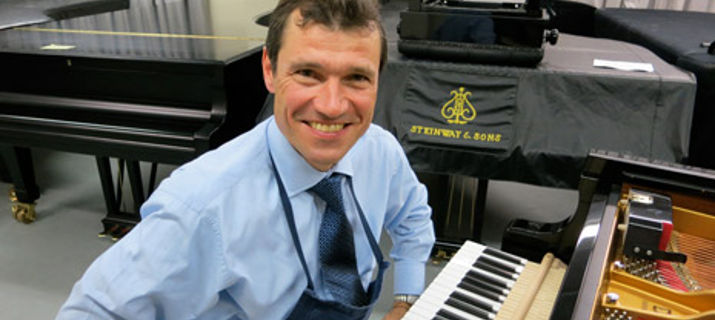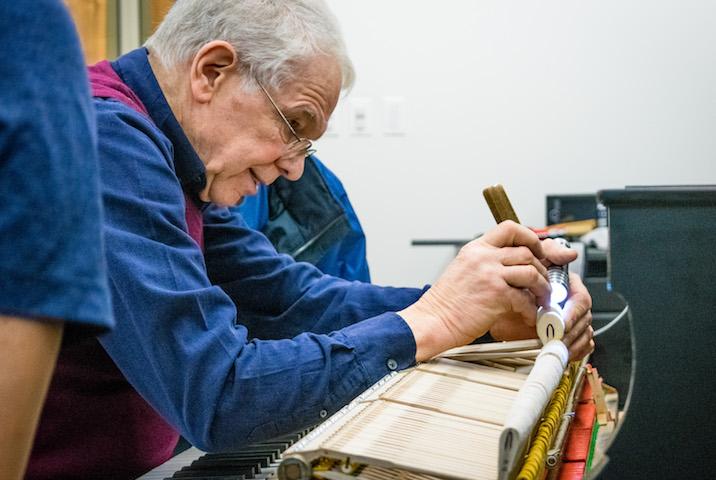Tuning & Voicing are essential to the health of your piano. To tune and piano and not voice it is to leave that piano with nothing to say. To voice a piano without first tuning it is like misspelling all the words of a great speech. You cannot deliver the best speech while stumbling on each word.
We prepare each note to respond to your musical input. As a result, every piece you play, whether a taxing classical piece from Prokofiev or a subtle jazz interlude from Bill Evans, is rendered with the musical ideas you had in mind. A piano that is ready to respond to your students will inspire them to new heights of accomplishment. Schedule a service call to start reaping the rewards of tuning & maintenance.
FAQs about Tuning
1. How often should my piano be tuned?
A home piano should be tuned twice a year while an active teaching instrument needs tuning monthly. We discuss your piano’s condition, environment, and your requirements, with you, then develop a customized tuning & maintenance program. This way we keep your piano in prime playing condition based on your needs. Below are a few of the elements to consider when developing your plan:
- How often is the instrument played?
- What is the age and condition of the piano?
- Do pianists use excessive force?
- Are there expectations of a performance on this piano? Instruments used in concert halls or recording studios will require higher levels of performance.
- What expectations do performers/musicians have of the piano?
- Are environmental conditions controlled and how do they impact the health of the piano?
As a doctor monitors your health through regular exams, so our technicians monitor the health of your instrument for signs of problems. This way we correct issues before they become a problem and/or damage other parts.
2. Why do the strings in my piano keep breaking when the piano is tuned?
Take a piece of wire and bend it back and forth until it breaks. You created the conditions that cause a piano string to break. The vibrations of a string cause the metal to fatigue, resulting in the strings becoming brittle and breaking. The question is what caused the string to become fatigued to the point of failure?
- What was the quality of the manufacturing process for the string?
- Does the design/scale of the piano account for tension values?
- Are there environmental conditions reacting with the metal?
- How much force is being used by musicians when playing?
- What is the age and condition of the instrument and its strings?
Changing tension in the process of tuning a piano rarely causes a string to break. Most technicians will be glad to repair or replace the string for the cost of time and materials.
3. What is a ‘pitch raise’ and why does my piano need one?
Think of a pitch raise as a quick tuning to stretch the strings before a refined tuning is completed. This first tuning is necessary when a piano has strayed too far from the A440 standard. Returning a string to its proper pitch and tension will stretch the metal in the string, causing the string to be under pitch and out of tune in a short period of time. By raising the pitch of the string slightly over the target point, it has a chance to accommodate the new forces, stretch, and settle closer to the proper pitch. A second tuning sets the string to its final tension and pitch, resulting in a more stable tuning.
“Why raise the pitch? Can’t it just stay where it is?”
The answer to this question lies in the design of the piano. For the past one hundred years pianos have been designed around the standard pitch of A440. That is to say, the fundamental pitch for the A above middle C is 440 cycles per second. All the rest of the notes are tuned relative to this standard pitch.
When the instrument was designed, each string was given a specification as to its diameter, length, and tension in order to achieve the proper pitch as well as a specific character of the sound. If the tension of a string is too far from the design, the sound will change character, usually adversely, resulting in poor tone quality. Keeping your piano tuned to the right pitch is wise as it will allow the strings to perform their best.
There are exceptions to this standard such as when a piano’s structural condition is suspect or, in some cases, an orchestra selects a slightly different standard pitch. However, in most cases it is best to keep the tuning & maintenance of your instrument centered around the standard pitch of A440.
Our Mantra
There are a number of good tuner/technicians that change the string tension on each string until they are in a proper relationship. A few tuners will not only tune the strings but also voice the hammers so the tambour is improved. We do all of that and much more, making your piano sound and play its best, leaving you free to enjoy the music. We strive to be in the class of piano technicians that make you a better musician.


